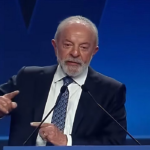
Hezbollah says it can and will fight until a Gaza ceasefire is agreed; here’s a breakdown of the scenarios:
Hezbollah is preparing for different scenarios as the low-level conflict between it and Israel threatens to escalate into something bigger.
Fueling the idea that Israel is shifting military focus from Gaza to Lebanon were statements from officials including Prime Minister Benjamin Netanyahu, who said on Sunday that Israel was ending operations in Rafah and refocusing on Lebanon.
Serious Israeli military action in Lebanon would draw in regional and possibly international actors.
Israel’s strikes have so far displaced nearly 100,000 people from their homes in southern Lebanon and killed at least 435 people, 349 of whom Hezbollah named as its members.
Hezbollah appears to be standing its ground, matching Israeli rhetoric with its own, and stepping up its cross-border attacks — which have so far killed 15 Israeli soldiers and 10 civilians, according to Israel.
The two have been exchanging cross-border attacks since the day after Israel launched a war on Gaza on October 7, when a Hamas-led operation in Israel killed 1,139 people, according to the AFP news agency.
Ceasefire or nothing
Hezbollah leader Hassan Nasrallah has repeatedly said in speeches since October that his group will stop its cross-border attacks on Israel only when it agrees to a ceasefire in Gaza.
Even if Israel turns most of its military attention to Lebanon, analysts believe Hezbollah will maintain its position.
“I don’t think Hezbollah will accept [negociações] in the absence of a ceasefire [em Gaza],” said Amal Saad, author of two books on Hezbollah. “The war will continue.
“Nasrallah said they will continue fighting until Hamas is victorious, and if Hamas is weakened and damaged, Hezbollah will not stand idly by,” she said.
“There is a strategic objective here… Hezbollah will not leave Hamas alone.”
The idea of a ceasefire appears to have hit a snag as Prime Minister Benjamin Netanyahu’s hardline coalition partners have demanded a “complete defeat of Hamas” before the war ends.
However, some Israeli officials have expressed doubts about the idea of a complete defeat of Hamas, stressing that Hamas is an idea and ideas cannot be eradicated.
Military spokesman Daniel Hagari expressed such doubts on June 19, while National Security Council head Tzachi Hanegbi said the same on Tuesday, less than a week later.
Whether in tacit acceptance of this idea or for other reasons, Israel is now talking about a phase of lower intensity, in which, it says, its army would continue to attack Hamas in Gaza while it seeks a political alternative for the group in the enclave.
A lower-intensity war in Gaza would, in theory, allow the focus to be placed on Lebanon – although this would require the Israeli army to face the challenge of engaging on two fronts.
Projecting force
For his part, Nasrallah has shown the power of his group and stood firm.
On June 19, he said his group has more than 100,000 fighters and that many leaders of regional armed groups have offered more fighters to join the fight against Israel, offers he rejected because Hezbollah is already “overburdened” with its own cadres.
A day before his speech, Hezbollah released drone footage over the Israeli city of Haifa, an implicit threat that the city could be targeted.
Another recent Hezbollah video showed what appears to be a series of targets inside Israel and in the Mediterranean Sea.
“Hezbollah is showing and simulating to Israel its options [para ampliar a] guerra… [isso fará com que Israel] understand that the repercussions are seriously costly,” said Imad Salamey, a political scientist at the Lebanese American University.
Nasrallah also threatened Cyprus, an island nation that is in the European Union but not NATO, if it supports Israel in the war.
Cyprus responded that it does not cooperate militarily with Israel in any conflict.
“Since October 8, Cyprus has been a key location where Israeli reservists fly in and then onward to Israel,” Seth Krummrich, a former special forces officer who is now at risk management firm Global Guardian, told Al Jazeera.
Israel has used Cypriot territory for training in the past.
The threat was Nasrallah’s way of signaling “to the European Union to refrain from supporting Israel in any way, which could imply [seus] member states,” Salamey said.
Contingency plans
While both sides escalate and show their cards, Hezbollah will have some contingency plans.
“Hezbollah probably has a strategy ready in case of a limited and prolonged war in southern Lebanon and has probably prepared a strategy in case of a full-scale war,” said Karim Emile Bitar, a professor of international relations at Saint Joseph University in Beirut.
A limited war would be what Salamey called an “asymmetric war of low-intensity attrition” that bleeds “the enemy through low-cost, efficient and effective skirmishes” — basically a continuation of the current conflict.

A full-scale war could intensify attacks across Lebanon, including on infrastructure like Beirut airport, as Israel did in 2006.
Some analysts believe a limited ground invasion of southern Lebanon is possible, although it would lead to heavy casualties on both sides.
For Bitar, Hezbollah probably does not want that option. “Hezbollah, like the Iranian regime, realizes that [uma escalada] would be extremely risky and devastating for Lebanon,” he said.
Intensified military threats and actions are occurring in parallel with diplomatic negotiations.
US Special Envoy Amos Hochstein was recently in Tel Aviv and Beirut, where he reportedly passed messages to Hezbollah through Lebanese parliament speaker and Hezbollah ally Nabih Berri.
According to unnamed Western diplomats who spoke to Axios, Hochstein told Hezbollah that it would be a mistake to assume the US could stop Israel from starting a wider war.
At the same time, Hezbollah and Israel are exchanging messages through French diplomats, Bitar said, seeking “a way out or a strategy that preserves dignity.”
If these negotiations result in “guarantees to Israel that Hezbollah allies would not be present within a 6-10 km radius [4-6 milhas] border and have no intention of using Hezbollah’s elite Radwan forces to attack Israel,” Hochstein’s efforts could bear fruit, Bitar said.

The parallel paths of diplomacy and military action are interconnected.
Still, there is an oft-repeated fear that a miscalculation could force an escalation, with neither side wanting to give their opponents the opportunity to declare a moral victory.
A war could still be avoided, barring this miscalculation or a political decision by Israel to go ahead, based on domestic considerations.
For its part, Hezbollah has maintained its position of demanding a ceasefire as its only precondition for stopping fighting.
“We are in a situation where, on both sides, internal political considerations prevail,” Bitar said.
“Hezbollah is aware that the majority of Lebanese, including a significant portion of its own supporters, do not want a new war,” he added.
“Both sides are taking these factors into consideration, however, we are in an extremely volatile situation and any miscalculation by either side could lead to a new full-scale conflict in the region.”
SOURCE: AL JAZEERA
Source: https://www.ocafezinho.com/2024/06/29/os-planos-do-hezbollah-as-ameacas-de-israel-algum-dos-lados-esta-pronto-para-a-guerra/

